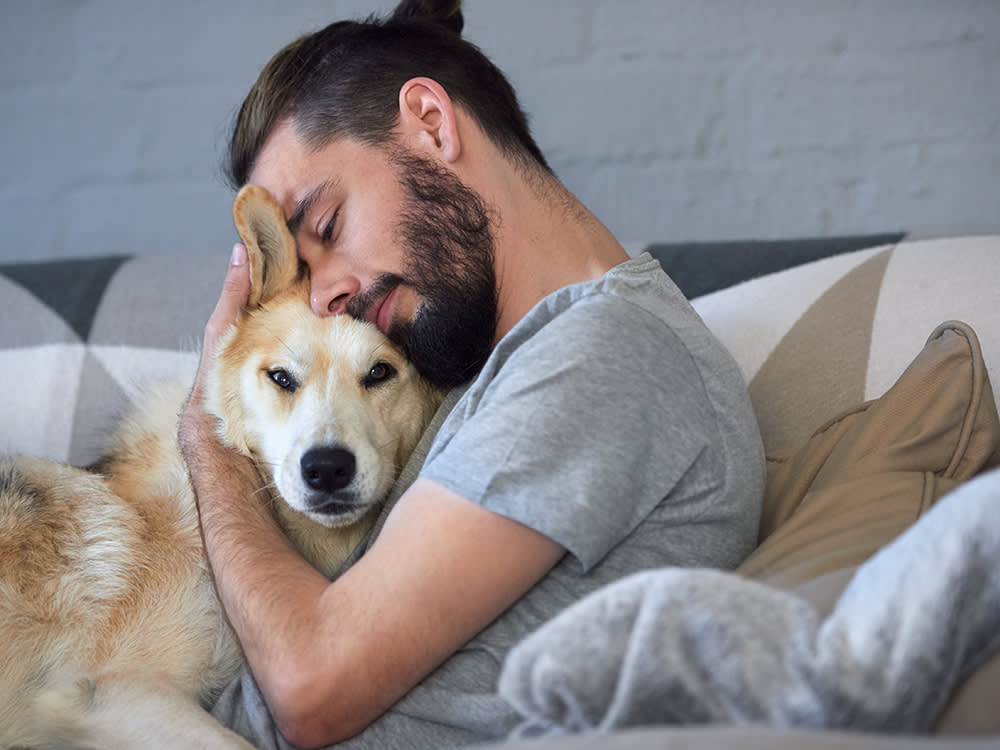How Will I Know When It’s Time?
End-of-life veterinary specialist Dr. Shea Cox on how to make the most difficult decision in your pet parenting journey.

share article

Your pet wants you to read our newsletter. (Then give them a treat.)
When our West Highland Terrier, Gus, was nine, we had our first human child, an event that effectively reset our family clock to zero. As Calder grew from infant to toddler to grade schooler, our tireless, inquisitive Gus remained strangely ageless for many years. His thick, eye-obscuring shag hid all signs of the passing years until, at nearly 15, he started having problems with mobility, then with bladder, then sphincter, until, by 2019, our little puppy was wearing canine diapers most of the time. Cataracts had also subtly occluded his vision, which seemed also to worsen his hearing. Our vet said that when these major senses are so degraded a dog regresses into himself and he becomes profoundly lost and scared, as if in late-stage Alzheimer’s. While we were still adjusting to geriatric pet care, Gus was about to teach us the hardest lessons of maturity, knowing when to let go. By the time he was whimpering and inconsolable at night, we knew it was time — a decision not even the most caring pet parents can expect to master.
Ralph Waldo Emerson seemed to recognize the larger issue here: “Sorrow makes us all children again — destroys all differences of intellect.” But I still wonder if we waited too long, what signs we might have missed, haunted by often-repeated folk wisdom about animals communicating their direst needs to us. As founder of PetHospiceopens in a new tab, Dr. Shea Cox, DVM, is a global expert in veterinary hospice and palliative care. She offers us reassuring corrections to certain bits of folk wisdom and valuable insights to facing this moment with your pet.
“Your Dog Will Tell You When It’s Time”
“That’s one of the sayings that I just wish I could erase some from the veterinarian vocabulary,” Dr. Cox says. “Because most parents don't know when it's time. It’s unclear more often than it’s not, and that’s putting a lot of pressure on someone who’s so in the moment — so connected to their pet — to make these kinds of decisions, and not to think, ‘What am I doing wrong as a pet parent?’”
The Quality-of-Life Scale
Veterinarian Dr. Alice Villalobos, DVM, introduced a seven-category “HHHHHMM” scale for dogsopens in a new tab and catsopens in a new tab to help evaluate your pet’s quality of life in its later stages, which provides a handy entry point for this conversation. The scale suggests giving a ranking from one-to-10 in certain categories — hurt, hunger, hydration, hygiene, happiness, mobility, and having more good days than bad. But the scale lacks nuances often crucial to making decisions. “Alice Villalobos is a very respected colleague, and I think that chart can be a wonderful tool,” says Dr. Cox. “But this scale doesn’t really weigh the separate factors against each other. You could have a pet who’s cleaning themselves, whose hygiene is good, who’s also eating well, but whose mobility is compromised due to pain. And to me, that pain trumps all the other quality of life factors.”
See the Animal, Not the Disease
Not all diseases and symptoms are equal. “One widely used signpost for knowing when it’s time is when they stop eating,” says Dr. Cox. “That’s another myth I would love to see go away. Your dog Gus had cognitive dysfunction. He’s still going to eat because that’s a physiological drive: his body's saying ‘I'm hungry.’ But eating does not equate to quality of life and hanging so much on that one bodily function can be very confusing to families. They’ll hear it and say, ‘Well, gosh, my pet is still eating so I guess he’s ok.’ It’s better to ask the family, ‘What joy is there?’ If the pet is laying in bed all day and it hurts when they get up, they may still be eating but there’s a lot more going on.”
But by the same token, bad symptoms don’t mean bad lives. “Pets can also be remarkably adaptable to changes in their life,” adds Dr. Cox. “I’ve seen so many hospice patients where veterinarians are making recommendations based on the disease, not the pet. Like, ‘Boy, your pet’s got this really nasty squamous cell carcinoma — which is an ugly tumor in the mouth — and it’s an aggressive disease so quality of life must not be good. Well, one cat I saw, Jacob, was a hospice patient in this exact situation. I actually went to his home, for euthanasia, where I had a look at him. Granted, this kitty had a big, nasty, stinky tumor. But he was rubbing on the owner and affection hopping in my bag and trying to pull up my treats. And I told his owner, ‘We don’t have to do this now, you know?’ We did get to a point where we did euthanize, but that was six weeks later. That allowed for more memories and time together. And if we wouldn’t have pushed into that decision, that owner would not have been able to have made, she would have felt guilty for doing it too soon. So there’s the opposite of waiting too late. It’s really hard to find that perfect time.”
“I was walking through these issues with one family — their pet was engaged, she was eating, but she was literally struggling to breathe. That symptom becomes a really weighted quality-of-life symptom.”
Imagine How It Feels
Some parts of life are weighted differently, including with a disease and its symptoms. What matters is how your pet experiences them. “You might have a pet with kidney disease, where you can manage symptoms adequately,” says Dr. Cox. “But you might have a pet with congestive heart failure, where that symptom is so much more disruptive to quality of life. I was walking through these issues with one family — their pet was engaged, she was eating, but she was literally struggling to breathe. That symptom becomes a really weighted quality-of-life symptom.
“Before I became a vet, I was a nurse for people in hospice, and one of my patients had end-stage heart disease that made her always struggle to breathe,” continues Dr. Cox. “She told me ‘I’m just essentially waiting to die,’ which I didn’t understand since she had so many visitors and she was clearly so loved. She gave me this little stirrer from her coffee and said to me, ‘Try to breathe through this.’ That really changed my perspective as a nurse, and later as a veterinarian. Often as pet parents we don’t understand these nuances, what they actually mean to the animal themselves.
“I was an emergency room veterinarian when I read that the average amount of face-time people have with their vet was 16 minutes a year. That’s not enough time for people to navigate the most important part of their journey with their pet. I left the emergency room setting and started to offer three-hour appointments focused on the most difficult part of the relationship. I started my own very small hospice and palliative care practice in 2012 that’s since grown to now we’re going into our six states nationwide.”
Good Moments Aren’t Good Days
In addition to hectic schedules, we all must manage our powerful emotional needs — including the need to have our beloved pets always with us. This kind of pull can cloud even the clearest guidelines, like more good days than bad ones. “I’ve found that what happens with families is what I call glimmers,” says Dr. Cox. “You have a pet that when you come home, they wag their tail and are so happy to see you — so she’s having a good day. But it’s important to consider how long that lasts during the day. That glimmer might happen for five or 10 minutes out of the day, but what’s happening the other 23 hours? Gosh, they ate two bites of a hot dog today and they weren’t eating at all yesterday. The abnormal becomes the new normal and you reset to that.”
“I’m speaking of this from experience,” says Dr. Cox. “because my boy Mickey had chronic kidney failure and my line in the sand was when that boy stops eating, I know it’s time. But I kept moving that line in the sand. His appetite got cut in half, so it became, ‘Well, he ate something, so I guess we’re still okay.’ Finally, I was like, ‘Shea, what are you doing?’ We try to put all these experiences into a tiny little box that makes sense. What I tell people to do is weigh the hurt against the comfort and the happiness. What is the overall happiness? To me, that trumps all the rest of the issues. Comfort and happiness — if we have those two in spades, we’re doing well.”
Your Quality of Life Matters Too
Part of facing facts is accepting our limitations as caregivers. “We have to look at our own quality of life, and how it’s being affected by our pet’s illness,” Dr. Cox says. “And do this without automatically feeling guilty — as if we love our pet less when a situation is unsustainable. It’s difficult when you have a pet whose body is still functioning, but their mind is failing. Or their mind is so sharp and engaged, but their body is failing. One of the most powerful things I’ve ever heard was this: Euthanasia is not shortening life, it’s shortening death. We focus so much on the fact that euthanasia is us taking another’s life. But what we’re really doing is speeding the death process. In a lot of these end-of-life situations, we’re always extending life through administering subcutaneous fluids or giving medications — taking all sorts of measures to prolong our animal’s life. And all of these are interventions, our pet would not survive without them. I realize that shortening the dying process through euthanasia feels a lot different, understandably, but it’s helpful to see it on a continuum.”
“A lot of it comes down to the fact that you want to do things for your pet, but never to your pet. I think that’s a line that we really have to keep in mind as we navigate this time.”
It Will Hurt No Matter What
Maybe it’s a blessing we’re very rarely given the power of life and death. Such powerful feelings sway us one way or another, and most of us want to postpone grief. “Often what we’re doing is moving from anticipatory grief to the grief that happens with a death,” says Dr. Cox. “Afterwards, it’s so easy to go into this woulda, shoulda, coulda game, as if hindsight will give you some answer.” My doctor sister often has to manage end-of-life care for her human patients and tells me a big part of this job is cutting through vagueness about what certain scary or painful life-preserving measures mean for the patient themselves. She tells me, “There are worse things you can do to a loved one than let them die.”
“Exactly,” says Dr. Cox. “That really ties into the idea of respecting the personality of your pet. There are things we can do that maybe we shouldn’t. My heart dog, my soul dog, Bauer, he had what we believe to be likely a nasal tumor. He’s this big 100-pound Doberman, and as a veterinarian working in a specialty hospital, I could do every test that needed to be done and you know, prognosis is good with radiation. You know, I could probably get eight to 18 months of improved quality of life and life extension. But he was a big scaredy cat and going to the hospital for those treatments every week or every two weeks would have affected his quality of life even though it would have improved my quality of life for having him around longer. A lot of it comes down to the fact that you want to do things for your pet, but never to your pet. I think that’s a line that we really have to keep in mind as we navigate this time. It’s one of the most important periods in you and your pet’s relationship. It’s important to be gentle on both of you.”

Chris Norris
Chris Norris is a writer, reporter, author, and longtime companion to West Highland terrier Gus, recently departed but intensely loved. Chris Norris is has written for The New Yorker, New York Magazine, The New York Times Magazine, Rolling Stone, GQ, Details, and NPR’s “All Things Considered.” He lives in New York City with his wife and 10-year-old son.

